In the bustling heart of a robotic assembly line, a tiny, unassuming device called a color sensor plays a crucial role. It is a silent sentinel, tirelessly scanning the world around it, deciphering the symphony of colors that dance before its eyes.
This sensor, a marvel of modern technology, doesn’t see the world like we do. It doesn’t perceive the beauty of a sunset or the vibrancy of a blooming rose. Instead, it translates the colors into an electrical signal, a language that machines understand.

Imagine a conveyor belt carrying a stream of colorful candies. The color sensor, perched atop the line, analyzes each candy as it passes by. Its task is simple: to identify the red candies and separate them from the rest. Using its internal logic, it compares the light reflected from the candy against its internal database of colors. If the light matches the color red, it triggers a signal, diverting the candy onto a designated path.
This seemingly mundane task is crucial for automation. The color sensor ensures that only the red candies are packaged, the green ones are sorted separately, and the blue ones are rejected. It’s a silent hero, working tirelessly behind the scenes, ensuring that the assembly line runs smoothly and efficiently.

It’s Applications:
But the color sensor’s capabilities extend far beyond candy sorting; used in a vast array of applications, from medical diagnostics to quality control in factories, from traffic light systems to robotic navigation.

In a hospital laboratory, a color sensor might analyze blood samples, identifying the presence of specific blood cells based on their color.
Inside an automobile factory, a color sensor could inspect car parts for defects, ensuring that only perfect components are assembled.
In the realm of art, it might help analyze paintings, revealing hidden details invisible to the naked eye.
In bustling factories, color sensors play a crucial role, tirelessly inspecting products for flaws. A rogue green chip amidst a sea of blue chips is instantly identified and discarded, ensuring flawless quality control.

Beyond the factory floor, color sensors navigate traffic lights, guiding vehicles through the urban jungle. They help farmers precisely control irrigation, ensuring crops thrive in their optimal conditions. They even assist medical professionals in analyzing blood samples, identifying diseases with unprecedented precision.
The color sensor is a quiet marvel, a silent guardian, meticulously scanning the world around us. Deciphering its chromatic language and influencing our lives in ways we often don’t even realize. It is a testament to the ingenuity of human invention, a device that allows us to see the world in a whole new light.
Shop below :



